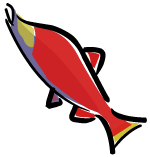
Salmon is a fish rich in omega-3 fatty acids, important for many bodily functions including brain and cardiovascular function. The choice to eat salmon and other “oily fish” is considered an important and healthy alternative to taking nutritional supplements because they are better absorbed by the body.
Health Benefits of Alaska Seafood
Alaska’s marine habitats are nearly pollution-free compared to the rest of the world. Feeding on organic marine organisms, Alaska Seafood is additive-free and provides healthful, natural vitamins, minerals, nutrients and heart-healthy polyunsaturated fats.
Alaska Seafood is naturally high in vitamins E, C, D and A. Some varieties are also very high in antioxidant E, which has proven to strengthen the immune system and lower the risk of heart disease by reducing buildup of plaque in coronary arteries. In addition, Alaska Seafood contains a wide variety of minerals, including zinc, iron, calcium and selenium.
Alaska Salmon has a richer color, firmer texture, and better flavor than industrially-produced salmon. This natural superiority results from a life spent feeding on the sea’s natural foods while swimming against the strong currents of the cold, clean North Pacific.
Omega-3: Alaska Salmon and Sablefish
Alaska Salmon is rich in Omega-3 oils, and Sablefish even more so. Scientists have known for years that Omega-3 offers heart-healthy benefits, including:
- Helping to decrease blood lipids (cholesterol, LDL’s, and triglycerides)
- Reducing blood clotting factors
- Increasing relaxation in larger arteries and blood vessels
- Decreasing the inflammatory processes in blood vessels
Additionally, the Omega-3 oils found in Alaska Salmon and Sablefish have been linked to improvements in or prevention of certain kinds of cancer, ulcerative colitis, psoriasis, arthritis, asthma, certain kinds of mental illness, depression and lupus.
Sources of Omega-3
The preferred choice for Omega-3 consumption is from eating seafood because the fat is better absorbed by the body and it comes with many other nutrients. Many modern diets aren’t high enough in Omega-3 oils to realize optimum health benefits. That’s why various types of seafood should be included in weekly diets.
Sockeye salmon provides 1200mg of Omega-3 per 100-gram portion and Sablefish boasts 1800mg per 100-gram portion- the highest of any Alaskan seafood. Studies have shown that including seafood in the diet two to four times a week can improve health. With a multitude of seafood species to choose from, you’re certain to meet the taste preferences of many while eating healthier.
Source: Alaska Seafood Marketing Institute




